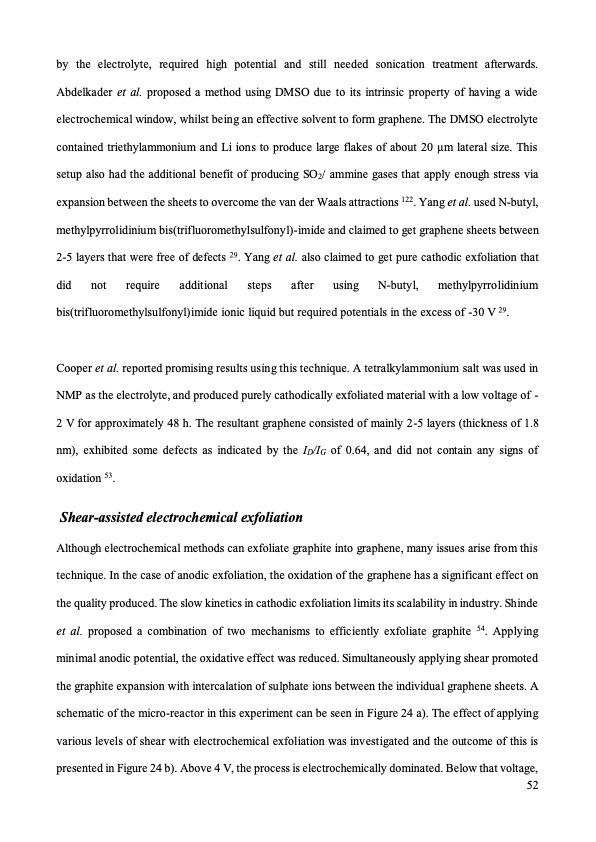
PDF Publication Title:
Text from PDF Page: 052
by the electrolyte, required high potential and still needed sonication treatment afterwards. Abdelkader et al. proposed a method using DMSO due to its intrinsic property of having a wide electrochemical window, whilst being an effective solvent to form graphene. The DMSO electrolyte contained triethylammonium and Li ions to produce large flakes of about 20 μm lateral size. This setup also had the additional benefit of producing SO2/ ammine gases that apply enough stress via expansion between the sheets to overcome the van der Waals attractions 122. Yang et al. used N-butyl, methylpyrrolidinium bis(trifluoromethylsulfonyl)-imide and claimed to get graphene sheets between 2-5 layers that were free of defects 29. Yang et al. also claimed to get pure cathodic exfoliation that did not require additional steps after using N-butyl, methylpyrrolidinium bis(trifluoromethylsulfonyl)imide ionic liquid but required potentials in the excess of -30 V 29. Cooper et al. reported promising results using this technique. A tetralkylammonium salt was used in NMP as the electrolyte, and produced purely cathodically exfoliated material with a low voltage of - 2 V for approximately 48 h. The resultant graphene consisted of mainly 2-5 layers (thickness of 1.8 nm), exhibited some defects as indicated by the ID/IG of 0.64, and did not contain any signs of oxidation 53. Shear-assisted electrochemical exfoliation Although electrochemical methods can exfoliate graphite into graphene, many issues arise from this technique. In the case of anodic exfoliation, the oxidation of the graphene has a significant effect on the quality produced. The slow kinetics in cathodic exfoliation limits its scalability in industry. Shinde et al. proposed a combination of two mechanisms to efficiently exfoliate graphite 54. Applying minimal anodic potential, the oxidative effect was reduced. Simultaneously applying shear promoted the graphite expansion with intercalation of sulphate ions between the individual graphene sheets. A schematic of the micro-reactor in this experiment can be seen in Figure 24 a). The effect of applying various levels of shear with electrochemical exfoliation was investigated and the outcome of this is presented in Figure 24 b). Above 4 V, the process is electrochemically dominated. Below that voltage, 52PDF Image | graphene production via nonoxidizing liquid exfoliation

PDF Search Title:
graphene production via nonoxidizing liquid exfoliationOriginal File Name Searched:
Graphene-R2-review.pdfDIY PDF Search: Google It | Yahoo | Bing
Salgenx Redox Flow Battery Technology: Power up your energy storage game with Salgenx Salt Water Battery. With its advanced technology, the flow battery provides reliable, scalable, and sustainable energy storage for utility-scale projects. Upgrade to a Salgenx flow battery today and take control of your energy future.
| CONTACT TEL: 608-238-6001 Email: greg@infinityturbine.com | RSS | AMP |